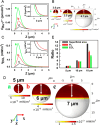Imaging and Simulation of Ruthenium Derivative Coating Microbeads at the Opaque Electrode with Electrogenerated Chemiluminescence
- PMID: 39474134
- PMCID: PMC11503937
- DOI: 10.1021/cbmi.3c00042
Imaging and Simulation of Ruthenium Derivative Coating Microbeads at the Opaque Electrode with Electrogenerated Chemiluminescence
Abstract
Electrogenerated chemiluminescence (ECL) imaging is gaining increasing attention in various fields because of its high sensitivity, low background, and good temporal and spatial resolution. However, ECL imaging of microsized objects at the opaque electrode via top-view configuration is challenged with the reactants' diffusion and light propagation. Here, we imaged and numerically simulated ruthenium derivative coating polystyrene microbeads (Ru1-PS@MB) at the glassy carbon electrode (GCE) via top-view configuration by ECL imaging. The ruthenium derivative (bis(2,2'-bipyridine)-4'-methyl-4-carboxybipyridine-ruthenium N-succinimidyl ester-bis (hexafluorophosphate), Ru1), a typical ECL reagent, was covalently linked onto the surface of aminated PS@MBs via the amide reaction. "Strong emission in edge and weak emission in center" phenomena for fluorescence (FL) and ECL emissions were obtained from Ru1-PS@MB on GCE. Z-Stack imaging of the microsized Ru1-PS@MB luminescence was performed on GCE in the presence of tri-n-propylamine (TPA). It is found that the clear luminescence range of Ru1-PS@MB perpendicular to the electrode surface in ECL image is slightly smaller than that in the FL image. The bigger was the diameter of the microbeads (from 5 to 18 μm), the larger was the ECL luminescence range of Ru1-PS@MB perpendicular to the electrode surface (from 5 to 7 μm). Our findings, which are also supported by numerical simulation, provide insights into the ECL imaging of microsized objects at the electrode surface, which will raise promising ECL applications in bioassays and cell imaging at the microscale level.
© 2023 The Authors. Co-published by Nanjing University and American Chemical Society.
Conflict of interest statement
The authors declare no competing financial interest.
Figures






References
-
- Shi Z.; Li G.; Hu Y. Progress on the application of electrochemiluminescence biosensor based on nanomaterials. Chin. Chem. Lett. 2019, 30, 1600–1606. 10.1016/j.cclet.2019.04.066. - DOI
-
- Liu Y.; Guo W.; Su B. Recent advances in electrochemiluminescence imaging analysis based on nanomaterials and micro-/nanostructures. Chin. Chem. Lett. 2019, 30, 1593–1599. 10.1016/j.cclet.2019.05.038. - DOI
-
- Engstrom R. C.; Pharr C. M.; Koppang M. D. Visualization of the edge effect with electrogenerated chemiluminescence. J. Electroanal. Chem. 1987, 221, 251–255. 10.1016/0022-0728(87)80262-0. - DOI
LinkOut - more resources
Full Text Sources
Miscellaneous
